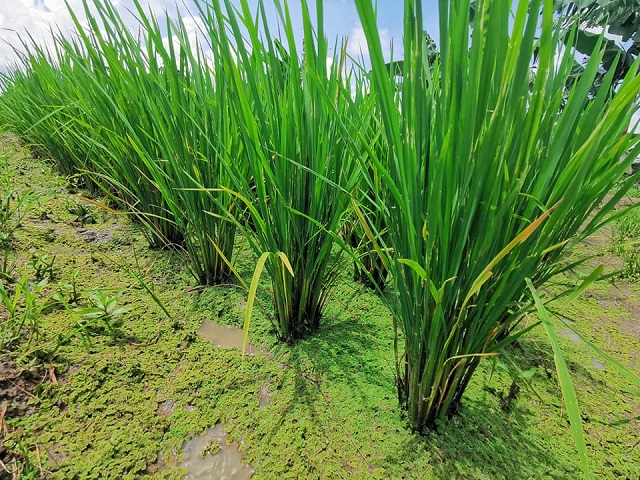
Intercropping Azolla with rice can help lessen farmers’ fertilizer expenses in rice production in irrigated areas, a research by the Department of Agriculture–Philippine Rice Research Institute (DA-PhilRice) showed.
Azolla, a fern that thrives in freshwater, maintains a symbiotic relationship with the blue-green algae, Anabaena azollae. The algae provide nitrogen (N) to the fern and the fern provides a habitat for the algae. This symbiosis allows the conversion of nitrogen into ammonia, which can be used by rice plants when incorporated into the soil.
“Our computation shows that farmers can save P17,500/year if they use Azolla as biofertilizer for rice. It can also increase their rice yield to 1t/ha,” Cielo Luz C. Mondejar, DA-PhilRice researcher, said.
She said that if Azolla covers the floodwaters of 1-ha rice paddy, it can supply 30kg N, which can replace at least 50% of the inorganic N requirement of rice without lowering the yield.
“The azolla-anabaena association can fix about 1.2kg N/ha daily or about 864kg N/ha annually, which is equivalent to about 34 bags of urea,” she explained.
Mondejar and her team put up a demonstration farm at DA-PhilRice in Negros to show the benefits of Azolla in rice production.
She said that many studies have been done on the effectiveness of Azolla as an alternative or supplementary fertilizer in flooded rice cropping system. One of these studies revealed that it increases humus content, which ultimately improves the physical, chemical, and biological soil conditions. Another study showed that Azolla intercropped with rice also reduces weed population.
A DA-PhilRice study also proved that growing of Azolla in the rice field is an alternative way to minimize golden apple snail damages in transplanted rice.
“We’re putting up this demonstration farm for more farmers to know about the benefits of Azolla in rice production,” she said.
Mondejar said that the demo farm, which was put up in January 2021, also shows the use of Azolla in fertilizing vegetables and feed to animals such as ducks, chickens, and tilapia.
“With 22-37% crude protein content of Azolla, farmers could raise livestock and poultry without the need for high protein commercial feeds,” she added.
Farmers are allowed to visit the organic demonstration farm at DA-PhilRice, Marañon, Cansilayan, Murcia, Negros Occidental. For information on Azolla production in rice paddies, visit https://bit.ly/3iSR2o4.




